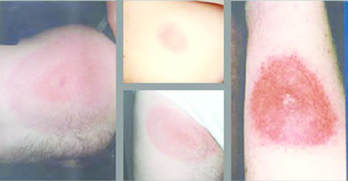While questing, ticks hold onto leaves and grass by their third and fourth pair of legs. They hold the first pair of legs outstretched, waiting to climb on to the host. When a host brushes the spot where a tick is waiting, it quickly climbs aboard. Some ticks will attach quickly and others will wander, looking for places like the ear, or other areas where the skin is thinner.
Depending on the tick species and its stage of life, preparing to feed can take from 10 minutes to two hours. When the tick finds a feeding spot, it grasps the skin and cuts into the surface. The tick then inserts its feeding tube. Many species also secrete a cement-like substance that keeps them firmly attached during the meal. The feeding tube can have barbs, which help keep the tick in place. Ticks also can secrete small amounts of saliva with anesthetic properties so that the animal or person can’t feel that the tick has attached itself. If the tick is in a sheltered spot, it can go unnoticed.
Protecting Yourself Against Ticks
Use repellents that contain 20 to 30% DEET (N, N-diethyl-m-toluamide) on exposed skin and clothing for protection that lasts up to several hours. Always follow product instructions.
Use products that contain permethrin on clothing. Treat clothing and gear, such as boots, pants, socks, and tents with products containing 0.5% permethrin. It remains protective through several washings. Pre-treated clothing is available and may be protective longer.
Removing Ticks
To remove a tick, grasp it with tweezers as close to the skin as possible and pull straight out.
Conduct a full-body tick check using a hand-held or full-length mirror to view all parts of your body upon return from tick-infested areas. Check for ticks under the arms, in and around the ears, inside the belly button, behind the knees, between the legs, around the waist, and especially in the hair. Ticks can ride into the home on clothing, then attach to a person later, so carefully examine clothing and gear.
Tumble clothes in a dryer on high heat for half an hour to kill remaining ticks. Some research suggests that shorter drying times may also be effective, particularly if the clothing is not wet.
If you develop a rash, body aches and pains or fever within several weeks of removing a tick, see your doctor.
Tick paralysis is a rare disease thought to be caused by a toxin in tick saliva. The symptoms include acute, ascending, flaccid paralysis that is often confused with other neurologic disorders or diseases (e.g., Guillain-Barré syndrome or botulism). Within 24 hours of removing the tick, the paralysis typically subsides.
Tickborne diseases can result in mild symptoms treatable at home to severe infections requiring hospitalization. Although easily treated with antibiotics, these diseases can be difficult for physicians to diagnose. However, early recognition and treatment of the infection decreases the risk of serious complications.




 RSS Feed
RSS Feed
